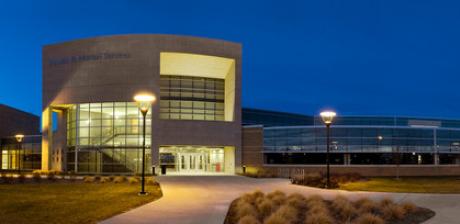March 26, 2012
The Brain research Lab opens at SVSU
The new laboratory at SVSU is now open. Almost 3000 square feet of space dedicated to providing opportunities for students to be involved in all aspects of research into neuroplasticity, brain injury, and degeneration. Within the lab, there are several specialized spaces to allow for all aspects of neuroscience to be explored.
Specialized spaces include...
The Wet Lab: that is fully equipped for cell and histological procedures. Some of the equipment includes C02 incubators, -80 freezer, centrifuge, invert microscope, fume hoods, tissue embedding workstation, tissue processor, histology station, automated slide staining system.
 Microscopy Suite: An important aspect of the work we do revolves around verifying the changes we see at the behavioral level with changes we see at the cellular level. The cornerstone of these activities will be a brand new, state of the art, confocal microscope. This system, the Olympus FV10i system produces amazing images, includes high level analysis software, and is really pretty easy to use (especially compared to traditional confocal systems). The system is completely software driven and allows for undergraduates (the system is very durable) to participate in all aspects of the analysis of the tissue. In addition we will also have a traditional light/fluorescence microscopy system.
Microscopy Suite: An important aspect of the work we do revolves around verifying the changes we see at the behavioral level with changes we see at the cellular level. The cornerstone of these activities will be a brand new, state of the art, confocal microscope. This system, the Olympus FV10i system produces amazing images, includes high level analysis software, and is really pretty easy to use (especially compared to traditional confocal systems). The system is completely software driven and allows for undergraduates (the system is very durable) to participate in all aspects of the analysis of the tissue. In addition we will also have a traditional light/fluorescence microscopy system.
Behavioral Testing Suite: A large, multi-use space which will include five computer controlled operant conditioning stations, five activity chambers, video tracking system, Morris water maze, Barnes maze, Gemini avoidance system, Staircase task, Roto-rod system, and a SR-lab system.
The Procedure Room: A state of the art surgery room that allows for several surgical procedures to be performed. We will have the resources to perform multiple types of procedures allowing for a myriad of questions to be explored.
The Cage Washing Room: Doesn't sound like this is too exciting of a space...well, ask any of my former students, they will be very jealous! Usually the cage washers are the students that work in the laboratory, instead, we have equipment to help take on that burden! A large amount of space and equipment have been invested in a nearly automated system to allow for less time required to the management of working with small animals and more time to be focused on the science.
